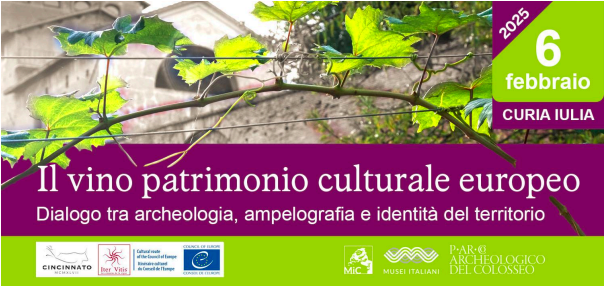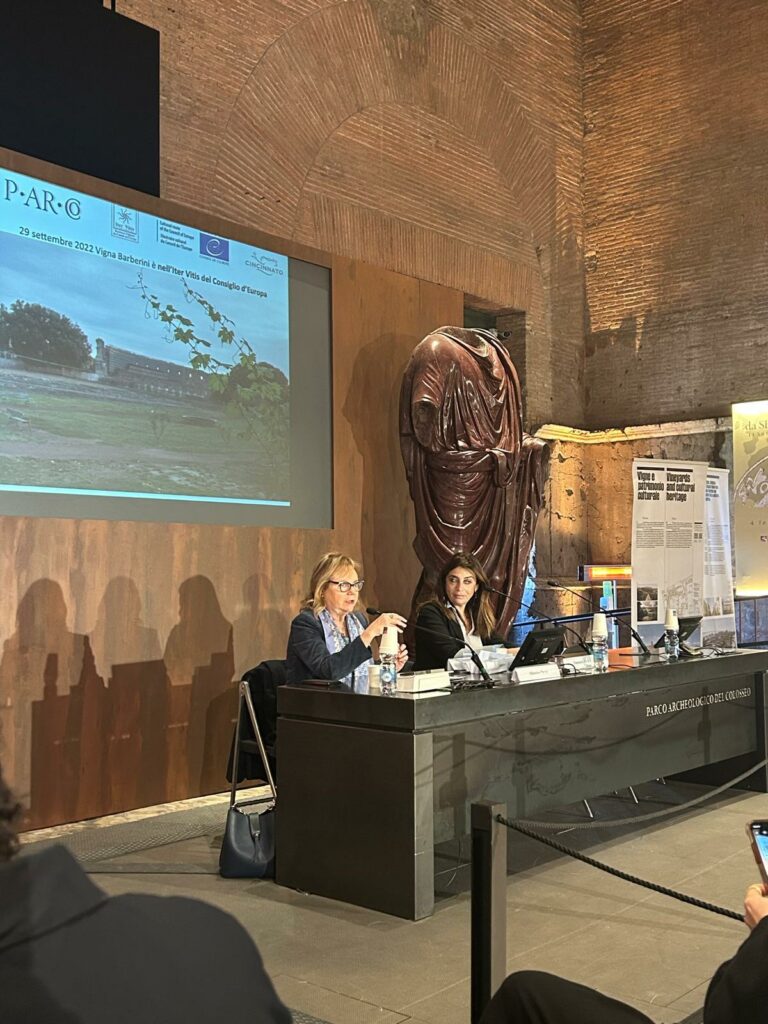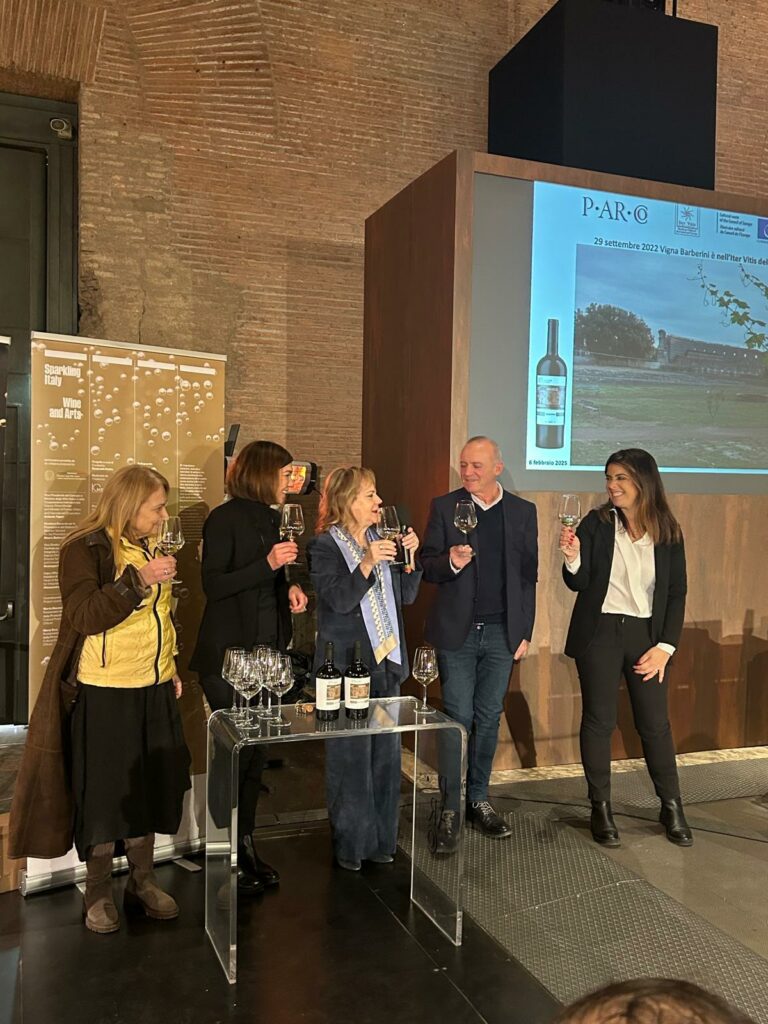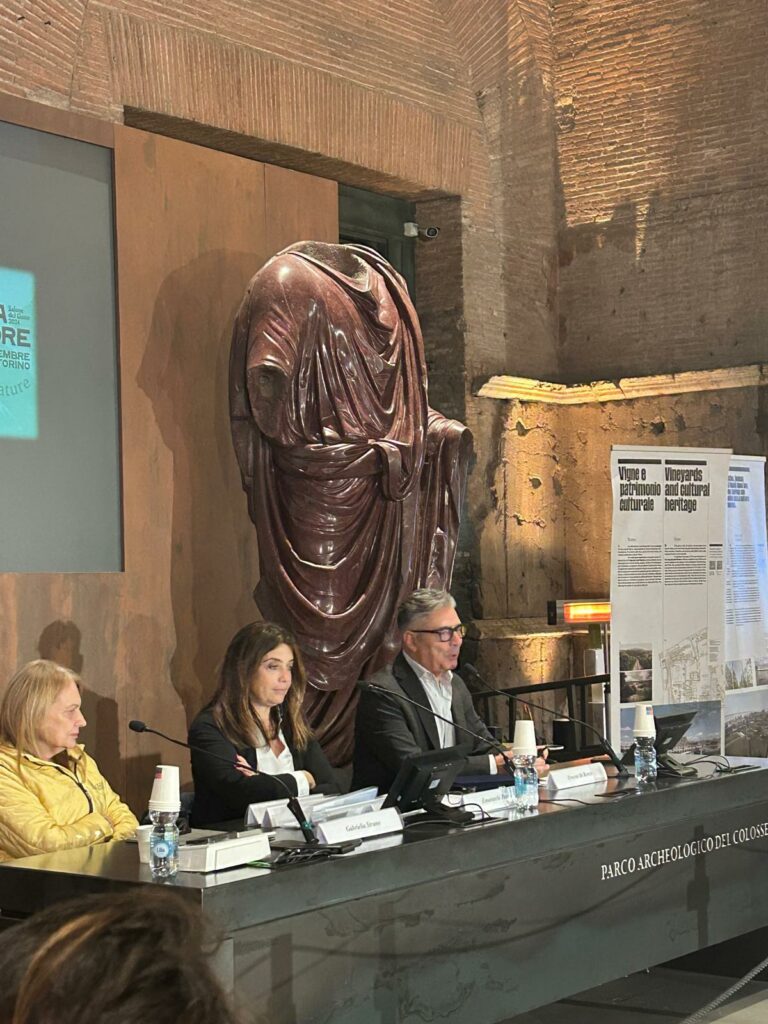A unique gathering of wine and cultural industry in the stunning frame of the Archeological Park of Colosseum in Rome
Wine as European Cultural Heritage: A Strategic Dialogue Between the Cultural and Viticultural Industries to Enhance Territorial Identity
The conference titled Wine as European Cultural Heritage held on February 6th in the historic setting of the Curia Julia at the Parco Archeologico del Colosseo highlighted wine’s role not just as an agricultural product but as a cornerstone of Europe’s cultural identity.
Promoted by Iter Vitis – Cultural Route of the Council of Europe, in collaboration with the Parco Archeologico del Colosseo and Cantina Cincinnato, this event provided a unique platform for dialogue among cultural institutions, industry experts, archaeologists, anthropologists, and wine producers. It underscored the intrinsic link between viticulture, historical heritage, and the sustainable development of territories.
A Meeting of History, Archaeology, and Viticulture
The conference showcased innovative approaches to protecting and enhancing viticultural heritage, focusing on the recovery of native grape varieties, the role of urban vineyards in historical landscapes, and the connection between museums and wine culture.
The cultural industry’s pivotal role in narrating and promoting the historical value of viticulture was evident through several impactful presentations:
- The Role of Archaeological Museums: Examples from the Archaeological Museums of Thessaloniki and Heraklion, alongside the Cité du Vin in Bordeaux, illustrated how museums can narrate the story of historic viticulture.
- The Venissa Project: A case study demonstrating the revival of Venetian viticulture and its contribution to sustainable tourism in the lagoon.
- The Vigna Barberini and the Inaugural Presentation of Augusto Wine: Highlighting the first winemaking experiment using grapes cultivated within the Parco Archeologico del Colosseo.
Augusto Wine: Reviving Historical Viticulture
One of the event’s most significant moments was the official unveiling of Augusto Wine, produced by Cantina Cincinnato using grapes from the experimental Vigna Barberini vineyard, situated in the heart of the Parco Archeologico del Colosseo. This project, led by Architect Gabriella Strano, is a groundbreaking endeavor in reviving historical viticulture within an archaeological site, honoring ancient Roman winemaking techniques.
Nazzareno Milita, President of Cantina Cincinnato, remarked, “Presenting Augusto Wine in this context is both an extraordinary milestone and a profound emotion. This project merges scientific research, historic landscape preservation, and the valorization of viticulture as a key element of Mediterranean culture.”
Venissa: Cultural Regeneration Through Wine
Gianluca Bisol, President of Venissa, shared insights into how the Venissa project exemplifies environmental preservation, the revival of traditions, and cultural innovation. By rediscovering the Dorona di Venezia grape, a native variety on the brink of extinction, Venissa has positioned itself as a model for territorial regeneration.
Through an experiential journey that combines viticulture, gastronomy, and the lagoon’s landscape, Venissa offers an alternative to mass tourism, emphasizing sustainability and local heritage. “The story of the Dorona grape and Venetian viticulture is a tangible example of how wine can serve as a bridge between past and future, culture and sustainability,” Bisol noted.
The Israeli Experience: Innovation Rooted in History
Shira Granot shared a compelling perspective on Israeli viticulture, highlighting the connection between ancient winemaking traditions and cutting-edge innovation. From the archaeological sites in the Judean Hills, the Wines of the Bible area, and Nabatean locations in the Southern part of the country, where remnants of ancient vineyards and presses have been discovered, to the groundbreaking technology that enables wine production in the arid conditions of the desert, Israel’s story illustrates a dynamic blend of history and modernity. This innovative approach not only preserves historical heritage but also paves the way for sustainable viticulture in challenging environments.
Designed by the Combat Antisemitism Movement (CAM), the Israel Wine Collection (IWC) aims to highlight the significance of the wine industry and its role in telling the broader story of Israel. Through Wine Diplomacy IWC offers an opportunity to discover Israel through the lens of its wine, symbolizing its rich history, heritage, and complex reality. Co founded by Shira Granot Director of Community Engagement & Sacha Roytman CEO – CAM
Roma Mater Vinorum: Rome as the Mother of Wines
Professor Ernesto Di Renzo, renowned anthropologist, presented the Roma Mater Vinorum project, a fascinating initiative of Iter Vitis led by the Agriculture and Environment Council of Roma Capital City, dedicated to rediscovering and narrating the historical relationship between Rome and viticulture and replanting vineyards where they were used to be in the past. By exploring ancient texts, archaeological findings, and traditional practices, the project emphasizes Rome’s pivotal role as a hub of enological knowledge in antiquity. It highlights how the Eternal City’s cultural and historical landscapes have been shaped by the cultivation and appreciation of wine.
Moldova and the Domestication of the Vine
Ivan Muntean offered valuable insights into the history of viticulture in Moldova, focusing on the domestication of the vine in the region. Drawing from archaeological and genetic studies, Muntean illustrated how Moldova’s rich winemaking traditions starting from Cucuteni civilization (a 7000 years history) are deeply rooted in its historical and cultural identity. He emphasized the importance of preserving this heritage through modern practices that honor ancient techniques and foster sustainable development among other studying possible wine making productions based on vitis silvestris.
Wine Stories: A Journey Through Thessaloniki’s Archaeological Museum
Anastasia Gadolou introduced the Wine Stories itinerary, a unique exhibition within the Archaeological Museum of Thessaloniki. This innovative project intertwines archaeological artifacts, historical narratives, and interactive displays to trace the evolution of wine culture in the region. By engaging visitors with immersive storytelling, Wine Stories bridges the gap between the past and present, showcasing wine as an enduring symbol of social and cultural life.
Closing Reflections and Future Directions
Alfonsina Russo Director of the Archeological Park and Emanuela Panke, President of Iter Vitis, emphasized the conference’s cruciality and the critical need for collaboration between the cultural and viticultural sectors. “This conference reaffirmed that wine is a cultural heritage in its own right, an essential component of European identity that deserves to be preserved and celebrated through appropriate cultural tools. By bringing together experts from archaeology, anthropology, and viticulture, we have fostered a broader vision of wine’s role in the sustainable development of territories.”
Panke called for greater integration between scientific research, cultural policies, and territorial enhancement strategies to support a sustainable viticultural industry across Europe. “Iter Vitis will continue to work in this direction, promoting wine as a means of knowledge, responsible tourism, and cross-cultural dialogue. Strengthening partnerships among museums, universities, and wine producers is essential to fully valorize our oenological and cultural heritage.”
The event concluded with a resounding consensus: wine is an expression of history and the identity of European communities. Iter Vitis will persist in fostering collaborations among cultural entities, institutions, and producers to amplify wine’s role as a unifying element connecting people, territories, and cultures.



